BOSCH HEI7032C, HEI7032U, HEI7052C, HEI7052U, HEI7132C User Manual
...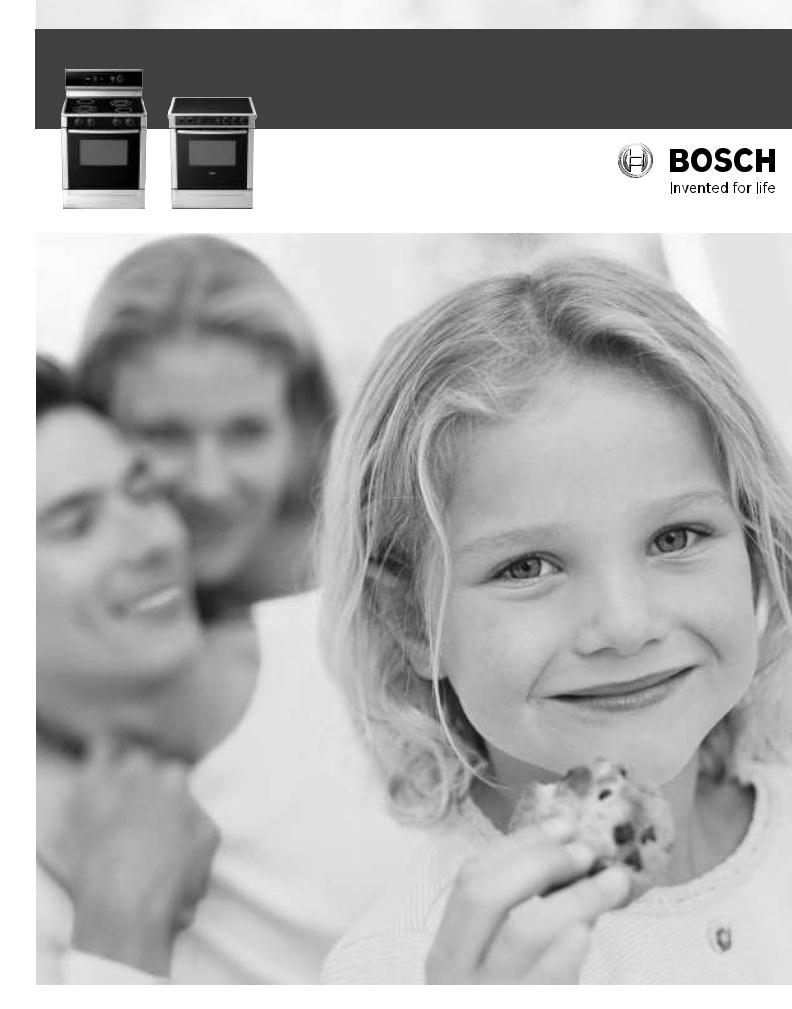
Use and Care Manual
Mode d’emploi et d’Entretien Instrucciones para usar y Cuidar
Electric Ranges with European Convection
fr |
Cuisinière Électriques avec Convection e Europénne |
es |
Cocina Electrica con Convección Europea |

Table of Contents
About This Manual . . . . . . . . . . . . . . . . . . . . . . . . . . . . . . . . . . . . . . . . . . . 1
How This Manual Is Organized . . . . . . . . . . . . . . . . . . . . . . . . . . . . . . . . . . . . . . . . . . . . . . . . . . . |
1 |
Safety . . . . . . . . . . . . . . . . . . . . . . . . . . . . . . . . . . . . . . . . . . . . . . . . . . . . . 1
Important Safety Instructions . . . . . . . . . . . . . . . . . . . . . . . . . . . . . . . . . . . . . . . . . . . . . . . . . . . . .1
Getting Started . . . . . . . . . . . . . . . . . . . . . . . . . . . . . . . . . . . . . . . . . . . . . . 5
Parts and Accessories . . . . . . . . . . . . . . . . . . . . . . . . . . . . . . . . . . . . . . . . . . . . . . . . . . . . . . . . . .5 Before Using the Appliance for the First Time . . . . . . . . . . . . . . . . . . . . . . . . . . . . . . . . . . . . . . .14
Operation - Cooktop . . . . . . . . . . . . . . . . . . . . . . . . . . . . . . . . . . . . . . . . . 14
About the Cooktop . . . . . . . . . . . . . . . . . . . . . . . . . . . . . . . . . . . . . . . . . . . . . . . . . . . . . . . . . . . .14
Operation . . . . . . . . . . . . . . . . . . . . . . . . . . . . . . . . . . . . . . . . . . . . . . . . . . . . . . . . . . . . . . . . . . .15
Operation - Oven . . . . . . . . . . . . . . . . . . . . . . . . . . . . . . . . . . . . . . . . . . . . 16
About the Oven . . . . . . . . . . . . . . . . . . . . . . . . . . . . . . . . . . . . . . . . . . . . . . . . . . . . . . . . . . . . . . .16
Operation . . . . . . . . . . . . . . . . . . . . . . . . . . . . . . . . . . . . . . . . . . . . . . . . . . . . . . . . . . . . . . . . . . .17
Operation - Warming Drawer (some models) . . . . . . . . . . . . . . . . . . . . . . 20
About the Warming Drawer . . . . . . . . . . . . . . . . . . . . . . . . . . . . . . . . . . . . . . . . . . . . . . . . . . . . .20 Operation . . . . . . . . . . . . . . . . . . . . . . . . . . . . . . . . . . . . . . . . . . . . . . . . . . . . . . . . . . . . . . . . . . .21
Getting the Most Out of Your Appliance . . . . . . . . . . . . . . . . . . . . . . . . . . 22
Getting the Most Out of Your Cooktop . . . . . . . . . . . . . . . . . . . . . . . . . . . . . . . . . . . . . . . . . . . . .22 Getting the Most Out of Your Oven . . . . . . . . . . . . . . . . . . . . . . . . . . . . . . . . . . . . . . . . . . . . . . .24 Getting the Most Out of Your Warming Drawer . . . . . . . . . . . . . . . . . . . . . . . . . . . . . . . . . . . . . .30
Cleaning and Maintenance . . . . . . . . . . . . . . . . . . . . . . . . . . . . . . . . . . . . 31
Care and Cleaning . . . . . . . . . . . . . . . . . . . . . . . . . . . . . . . . . . . . . . . . . . . . . . . . . . . . . . . . . . . .31
Maintenance . . . . . . . . . . . . . . . . . . . . . . . . . . . . . . . . . . . . . . . . . . . . . . . . . . . . . . . . . . . . . . . . .36
Service . . . . . . . . . . . . . . . . . . . . . . . . . . . . . . . . . . . . . . . . . . . . . . . . . . . 37
Self Help . . . . . . . . . . . . . . . . . . . . . . . . . . . . . . . . . . . . . . . . . . . . . . . . . . . . . . . . . . . . . . . . . . . .37
Warranty . . . . . . . . . . . . . . . . . . . . . . . . . . . . . . . . . . . . . . . . . . . . . . . . . . . . . . . . . . . . . . . . . . . .39
Questions?
1-800-944-2904
www.boschappliances.com 5551 McFadden Ave.
Huntington Beach, CA 92649
We look forward to hearing from you!
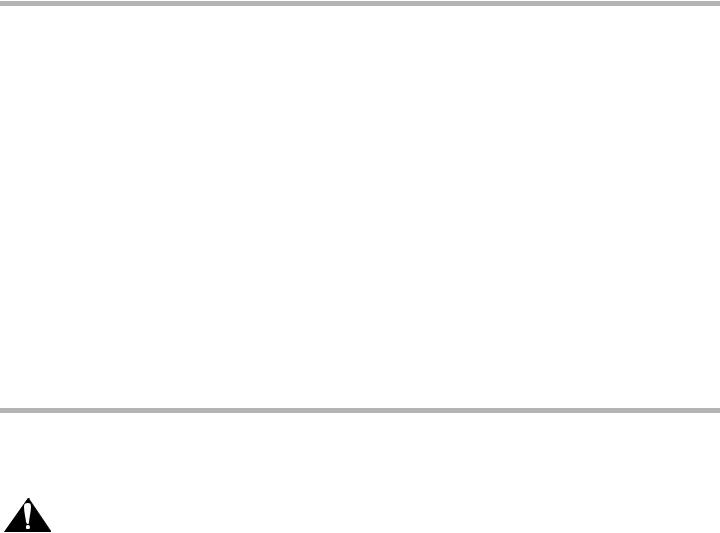
About This Manual
How This Manual Is Organized
This manual contains several sections:
•The Overview section describes the features and functionality of the range, including a description of how to set up the range and operate the range’s control panel.
•The three Operations sections describe how to operate and get the best performance out of each range component: the cooktop, oven, and warming drawer.
•The Cleaning and Maintenance section describes how to clean and maintain your range.
•The Service section includes troubleshooting tips and your Warranty.
Before using your range, be sure to read this manual. Pay special attention to the
Important Safety Instructions located at the beginning of the manual.
Safety
Important Safety Instructions
READ AND SAVE THESE INSTRUCTIONS
Important Safety Instructions
Fire Safety |
• Do not use aluminum foil or protective liners to line any part of an appliance, |
|
especially surface unit drip bowls or oven bottom. Installation of these liners |
|
may result in a risk of electric shock or fire. |
|
• If materials inside an oven or warming drawer should ignite, keep door closed. |
|
Turn off the appliance and disconnect the circuit at the circuit breaker box. |
|
• Use this appliance only for its intended use as described in this manual. For |
|
example, never use the appliance for warming or heating the room. Never use |
|
the appliance for storage. |
|
• Do not allow aluminum foil, plastic, paper or cloth to come in contact with a |
|
hot burner or grate. Do not allow pans to boil dry. |
|
• If the cooktop is near a window, forced air vent, or fan, be certain that flamma- |
|
ble materials such as window coverings do not blow over or near the burners |
|
or elements. They could catch on fire. |
|
• Always have a working smoke detector near the kitchen. |
|
• Never leave the cooktop unattended when in use. Boilovers cause smoking |
|
and greasy spillovers may ignite. |
|
• WARNING – TO REDUCE THE RISK OF A RANGE TOP GREASE FIRE: |
English 1
 Safety
Safety
1) Never leave surface units unattended at high settings. Boilovers cause smoking and greasy spillovers that may ignite. Heat oils slowly on low or medium settings.
2) Always turn hood ON when cooking at high heat or when flambéing food (i.e. Crepes Suzette, Cherries Jubilee, Peppercorn Beef Flambe’).
3) Clean ventilating fans frequently. Grease should not be allowed to accumulate on fan or filter.
4) Use proper pan size. Always use cookware appropriate for the size of the surface element.
• In the event that personal clothing or hair catches fire, drop and roll immediately to extinguish flames.
• Smother flames from food fires other than grease fires with baking soda. Never use water on cooking fires.
• WARNING – TO REDUCE THE RISK OF INJURY TO PERSONS IN THE EVENT OF A RANGE TOP GREASE FIRE, OBSERVE THE FOLLOWING: 1) SMOTHER FLAMES with a close-fitting lid, cookie sheet, or metal tray,
then turn off the burner. BE CAREFUL TO PREVENT BURNS. If the flames do not go out immediately, EVACUATE AND CALL THE FIRE DEPARTMENT.
2) NEVER PICK UP A FLAMING PAN – You may be burned.
3) DO NOT USE WATER, including wet dishcloths or towels – a violent steam explosion will result.
• Use an extinguisher ONLY if:
1) You know you have a Class ABC extinguisher, and you already know how to operate it.
|
2) The fire is small and contained in the area where it started. |
|
3) The fire department is being called. |
|
4) Use an extinguisher ONLY if: |
|
• Whenever possible, do not operate the ventilation system during a cooktop |
|
fire. However, do not reach through fire to turn it off. |
Burn Prevention |
• DO NOT TOUCH SURFACE UNITS OR AREAS NEAR UNITS - Surface |
|
units may be hot even though they are dark in color. Areas near surface units |
|
may become hot enough to cause burns. During and after use, do not touch, |
|
or let clothing, potholders, or other flammable materials contact surface units |
|
or areas near units until they have had sufficient time to cool. Among these |
|
areas are the cooktop and areas facing the cooktop. |
|
• DO NOT TOUCH HEATING ELEMENTS OR INTERIOR SURFACES OF |
|
OVEN - Heating elements may be hot even though they are dark in color. |
|
Interior surfaces of an oven become hot enough to cause burns. During and |
|
after use, do not touch, or let clothing, potholders, or other flammable materi- |
|
als contact heating elements or interior surfaces of oven until they have had |
|
sufficient time to cool. Other surfaces of the appliance may become hot |
|
enough to cause burns. Among these surfaces are oven vent openings, sur- |
|
faces near these openings and oven doors. |
|
• Exercise caution when opening the appliance. Standing to the side, open the |
|
door (or drawer) slowly and slightly to let hot air and/or steam escape. Keep |
|
your face clear of the opening and make sure there are no children or pets |
|
near the unit. After the release of hot air and/or steam, proceed with your |
|
cooking. Keep doors shut unless necessary for cooking or cleaning purposes. |
|
Do not leave open doors unattended. |
|
• Do not heat or warm unopened food containers. Build-up of pressure may |
|
cause the container to burst and cause injury. |
|
• Always place oven racks in desired location while oven is cool. If a rack must |
|
be moved while oven is hot, do not let potholder contact the heating elements. |
|
• Always use dry potholders. Moist or damp potholders on hot surfaces may |
|
result in burns from steam. Do not let potholder touch hot heating elements. |
|
Do not use a towel or other bulky cloth. |
|
• Always turn hood ON when cooking at high heat or when flambéing food (i.e. |
|
Crepes Suzette, Cherries Jubilee, Peppercorn Beef Flambe’). |
English 2 |
|
 Safety
Safety
• Use high heat settings on the cooktop only when necessary. To avoid bubbling and splattering, heat oil slowly on no more than a low-medium setting. Hot oil is capable of causing extreme burns and injury.
• Never move a pan of hot oil, especially a deep fat fryer. Wait until it is cool.
• Secure all loose garments, etc. before beginning. Tie long hair so that it does not hang loose, and do not wear loose fitting clothing or hanging garments, such as ties, scarves, jewelry, or dangling sleeves.
• Avoid reaching or leaning over the appliance. Be aware that certain clothing and hair sprays may contain flammable chemicals that could be ignited if brought in contact with hot surface units or heating elements and may cause severe burns.
|
• Do not touch interior surface of the drawer while it is in use. The interior of the |
|
drawer could become hot enough to cause burns. Allow drawer and rack (if |
|
equipped) to cool before handling. |
|
• WARNING: To prevent burns, do not remove drawer while hot. Be sure |
|
drawer is empty before removing. |
Child Safety |
• When children become old enough to use the appliance, it is the legal respon- |
|
sibility of the parents or legal guardians to ensure that they are instructed in |
|
safe practices by qualified persons. |
|
• Do not allow anyone to climb, stand, lean, sit, or hang on any part of an appli- |
|
ance, especially a door, warming drawer, or storage drawer. This can damage |
|
the appliance, and the unit may tip over, potentially causing severe injury. |
|
• Do not allow children to use this appliance unless closely supervised by an |
|
adult. Children and pets should not be left alone or unattended in the area |
|
where the appliance is in use. They should never be allowed to play in its |
|
vicinity, whether or not the appliance is in use. |
|
• CAUTION - Items of interest to children should not be stored in an appliance, |
|
in cabinets above an appliance or on the backsplash. Children climbing on an |
|
appliance to reach items could be seriously injured. |
Cleaning Safety |
• IMPORTANT SAFETY NOTICE: The California Safe Drinking and Toxic |
|
Enforcement Act requires the Governor of California to publish a list of sub- |
|
stances known to the state to cause cancer, birth defects or other reproduc- |
|
tive harm, and requires businesses to warn customers of potential exposure |
|
to such substances. The burning of gas cooking fuel and the elimination of |
|
soil during self-cleaning can generate small amounts of Carbon Monox- |
|
ide.The fiberglass insulation in self-clean ovens gives off very small amounts |
|
of formaldehyde during the first several cleaning cycles. California lists form- |
|
aldehyde as a potential cause of cancer. Carbon Monoxide is a potential |
|
cause of reproductive toxicity.Exposure to these substances can be mini- |
|
mized by: |
|
1) Providing good ventilation when cooking with gas. |
|
2) Providing good ventilation during and immediately after self cleaning the |
|
oven. |
|
3) Operating the unit according to the instructions in this manual. |
|
• Do not clean the appliance while it is still hot. Some cleaners produce noxious |
|
fumes when applied to a hot surface. Wet cloths or sponges can cause burns |
|
from steam. |
|
• When self-cleaning, confirm that the door locks and will not open. If the door |
|
does not lock, do not run Self-Clean. Contact service. |
|
• Birds have very sensitive respiratory systems. Keep pet birds out of the |
|
kitchen or other rooms where kitchen fumes could reach them. During self |
|
clean, fumes are released that may be harmful to birds. Other kitchen fumes |
|
such as overheating margarines and cooking oils may also be harmful. |
|
• Keep oven free from grease build up. |
Cookware Safety |
• Do not place food directly on oven bottom. |
|
• Follow the manufacturer’s directions when using cooking or roasting bags. |
English 3

 Safety
Safety
•Hold the handle of the pan when stirring or turning food. This helps prevent spills and movement of the pan.
•Use Proper Pan Size. The use of undersized cookware will expose a portion of the heating element or burner to direct contact and may result in ignition of clothing. Select cookware having flat bottoms large enough to cover the surface heating unit. This appliance is equipped with one or more surface units of different size. Proper relationship of cookware to heating element or burner will also improve efficiency.
•Cookware not approved for use with glass ceramic cooktops may break with sudden temperature changes. Use only pans that are appropriate for glass ceramic cooktops (only certain types of glass, heatproof glass, ceramic, earthenware, or other glazed utensils are suitable). See Cookware Selection Guide for further details.
•Always position handles of utensils inward so they do not extend over adjacent work areas, burners, or the edge of the cooktop. This reduces the risk of fires, spills and burns.
•CAUTION: Plastic containers or plastic wrap can melt if in direct contact with the drawer or a hot utensil. If it melts onto the drawer, it may not be removable.
Proper Installation and Maintenance • WARNING: When properly cared for, your new appliance has been designed to be safe and reliable. Read all instructions carefully before use. These precautions will reduce the risk of burns, electric shock, fire, and injury to persons. When using kitchen appliances, basic safety precautions must be followed, including those in the following pages.
•Have the installer show you the location of the circuit breaker or fuse. Mark it for easy reference.
•This appliance must be properly installed and grounded by a qualified technician. Connect only to a properly grounded outlet. Refer to Installation Instructions for details.
•All ranges can tip. Injury to persons could result. Install anti-tip device packaged with range. Verify that the anti-tip devices are engaged. See installation instructions.
Figure 1: Tipping Precautions
•This appliance is intended for normal family household use only. It is not approved for outdoor use. See the Warranty. If you have any questions, contact the manufacturer.
•Do not store or use corrosive chemicals, vapors, flammables or nonfood products in or near this appliance. It is specifically designed for use when heating or cooking food. The use of corrosive chemicals in heating or cleaning will damage the appliance and could result in injury.
•Do not operate this appliance if it is not working properly, or if it has been damaged. Contact an authorized servicer.
•Do not cook on a broken cooktop. Cleaning solutions and spillovers may create a risk of electric shock.
•Do not obstruct oven vents.
•Do not repair or replace any part of the appliance unless specifically recommended in this manual. Refer all servicing to a factory authorized service center.
English 4
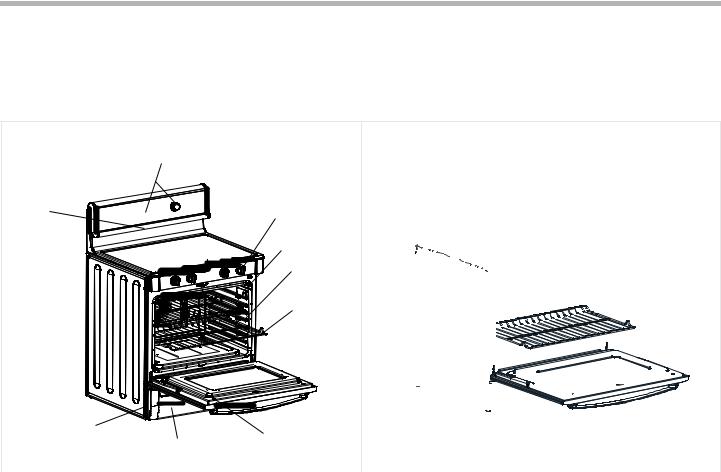
 Safety
Safety
|
• In the event of an error the display flashes and beeps continuously. If this |
|
|
happens during self-clean, disconnect appliance from the power supply and |
|
|
call a qualified technician. |
|
|
• In the event of an error the display flashes and beeps continuously. Discon- |
|
|
nect appliance from the power supply and call a qualified technician. |
|
Food Safety |
• CAUTION: To maintain food safety, follow these guidelines: |
|
|
1) |
DO NOT use a warming drawer to heat cold food (exception: it is safe to |
|
|
use the drawer to crisp crackers, chips or dry cereal and to warm plates. |
|
2) |
Be sure to maintain proper food temperature. The USDA recommends |
|
|
holding hot food at 140°F or warmer. |
|
3) |
DO NOT warm food for longer than one hour. |
Getting Started
Parts and Accessories
Free-Standing Models |
|
Slide-In Models |
|
|
|
1 |
|
|
|
10 |
2 |
10 |
1 |
|
|
2 |
|||
|
|
|
|
|
|
|
3 |
|
3 |
|
|
|
|
|
|
|
4 |
|
4 |
|
|
|
|
|
|
|
5 |
|
5 |
|
|
|
|
|
|
|
|
|
6 |
9 |
|
6 |
9 |
|
|
7 or 8 |
|
|
7 or 8 |
|
|
|
|
(model dependent) |
|
|
(model dependent) |
|
|
|
|
|
|
|
|
|
|
|
|
|
Figure 2: Parts and Accessories |
Table 1: Parts and Accessories Key
# |
Part |
# |
Part |
|
|
|
|
1 |
Oven Control Panel and Knob |
12 |
Cooktop Scraper (not shown) |
|
|
|
|
2 |
Cooktop Control Knob |
13 |
Weiman Cook Top® (glass ceramic cooktop cleaner) |
|
|
|
(not shown) |
|
|
|
|
3 |
Probe Receptacle |
14 |
Broiler Pan (not shown) |
|
|
|
|
4 |
Rack Positions/ Rack Guides |
15 |
Oven Rack, Half (some models) (not shown) |
|
|
|
|
5 |
Oven Racks, Flat (2 or 3; varies by model) |
16 |
Oven Rack, Full Extension (some models) (not shown) |
|
|
|
|
6 |
Oven Door Gasket |
17 |
Literature Package (not shown) |
|
|
|
|
7 |
Storage Drawer (some models)a |
18 |
Oven Lights (2) (oven back wall) (not shown) |
English 5
Getting Started
Table 1: Parts and Accessories Key
# |
Part |
# |
Part |
|
|
|
|
8 |
Warming Drawer (some models)a |
19 |
Convection Fan and Element (oven back wall; not |
|
|
|
shown) |
|
|
|
|
9 |
Model # and Serial # Plate |
20 |
Broil Element (top of oven interior) (not shown) |
|
|
|
|
10 |
Oven Vent |
21 |
Oven Door Lock (not visible) (not shown) |
|
|
|
|
11 |
Anti-Tip Bracket (not shown) |
|
|
|
|
|
|
a. Depending on the model, your appliance has either a storage drawer or a warming drawer.
Radiant Element |
The radiant element uses a wire ribbon located under the glass ceramic surface to |
|
provide the heat for cooking. The radiant element will cycle on and off by design |
|
(see Temperature Limiter). |
Dual Element |
The dual element consists of two radiant ribbon elements within the same heating |
|
area. Either the small inner element or both the inner and outer elements may be |
|
selected for use, in order to better match the size of cookware. |
Triple Element |
The triple element consists of three (small, medium and large) radiant ribbon ele- |
|
ments within the same heating area. Either the small element, the small and |
|
medium element or all three elements may be selected for use, in order to better |
|
match the size of cookware. |
Bridge Element (some models) |
The bridge element joins the front single element and the back single element to |
|
create one long oblong element. It is designed for use with large cookware such |
|
as long griddles and roasters. |
Retained Heat |
The glass cooking surface retains heat and stays hot after the element(s) have |
|
been turned off. The retained heat may be used to hold foods at serving tempera- |
|
tures for a short time. If a hot surface light is on, use caution when working or |
|
cleaning around the cooktop as the cooktop is still hot. |
Temperature Limiter |
Each radiant heating element has its own sensor to protect the glass cooking sur- |
|
face from extreme high temperatures. The limiters will operate automatically by |
|
cycling the element off regardless of the cook setting. |
|
Although cycling is normal, any one of the following conditions can activate the |
|
limiter and cause it to cycle on and off more than usual: |
|
• The base of the pan is not making full contact with the heating surface (due to |
|
a warped or uneven base). |
|
• The pan is too small for the element. |
|
• The pan has boiled dry. |
|
• The material or shape of the pan is slow to transfer the heat. |
Hot Surface Indicator |
The cooktop displays a hot indicator light to show when the cooking surface is too |
|
hot to touch. If a hot surface light is on, use caution when working or cleaning |
|
around the cooktop as the cooktop is still hot. |
Oven Racks |
Depending on model, the range is equipped with one of the following combina- |
|
tions: |
|
• Three flat racks |
|
• Two flat racks and one full extension rack |
|
• Two flat racks and one half rack |
Flat Oven Racks |
The racks are designed with a stop so they will stop before coming completely out |
|
of the oven and not tilt. |
English 6
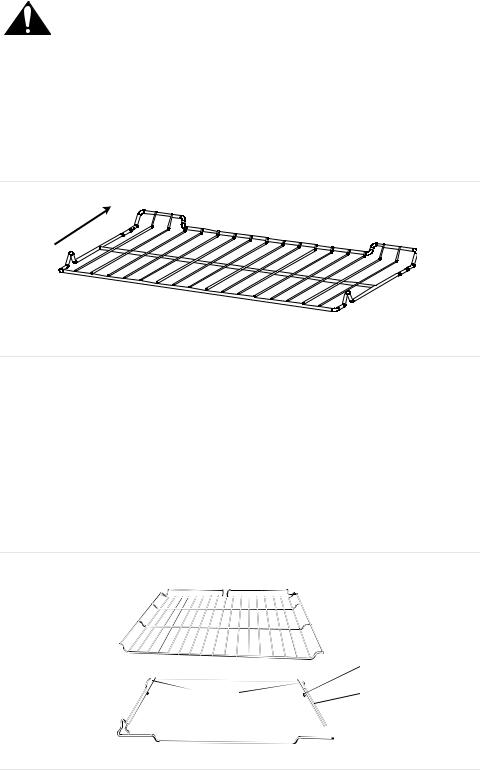
Extension Oven Rack (some models)
Getting Started
CAUTION
To avoid burns, place oven racks in desired positions before turning oven on. Always use oven mitts when the oven is warm.If a rack must be moved while the oven is hot, do not let oven mitts contact hot heating elements.
Inserting Racks Into Oven
1.Grasp rack firmly on both sides.
2.Tilt rack up to allow stop into rack guide.
3.Bring rack to a horizontal position and press the rest of the way in. Rack should be straight and flat, not crooked.
Back of rack
Front of rack
Insert rack with the back of the rack toward the back wall of the range.
Figure 3: Inserting a Rack
Removing Flat Racks From Oven
1.Grasp rack firmly on both sides and pull rack toward you.
2.When the stop is reached, tilt rack up and pull the rest of the way out.
The Full Extension Rack allows for easier access to cooking foods. The bottom section extends as far as the standard flat rack. However, the top section extends beyond the bottom section bringing the food closer to the user. To order a full extension rack, contact Service or a dealer near you.
Back of Rack |
Pan Stops |
Top Rack
Top Rack
 Stop (Ball)
Stop (Ball)
Bottom |
Stops |
Rack Guide |
Rack |
 Top Rack Rest
Top Rack Rest
Front of Rack
Figure 4: Full Extension Rack
Removing and Replacing
Note: The full extension rack must be in the closed position when removing and replacing. Grasp the entire rack (both sections).
1.Grasp the bottom section and pull straight out.
2.Once the stop is reached, grasp the top section and pull straight out until the second stop is reached. If the top rack will not extend fully, it is not installed correctly. Reinstall it so that the pan stop is in the back of the oven.
English 7
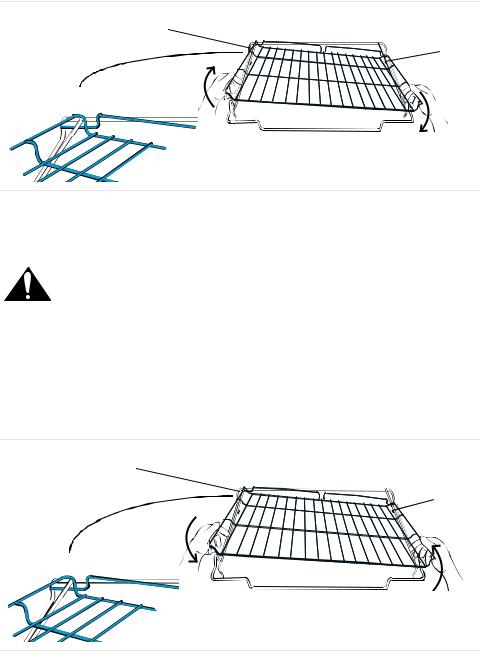
Getting Started
Disassembly (for cleaning)
The two sections of the rack are designed to come apart for easier cleaning.
1.Place rack on flat surface in the closed position top side up.
2.Rotate one side of top rack towards you until it is past the stop (ball).
3.Pull the rack up and out, rotated side first.
Closed Position |
Back of Rack |
|
Stop (Ball)
Front of Rack
Figure 5: Disassembly
Reassembly
CAUTION
Always verify that top rack is installed correctly after reassembly. The back edges of the top rack must be under the rack guide on the bottom rack. DO NOT simply rest the top rack on top of the bottom one.
1.To reassemble rack, hold top rack diagonally across bottom rack.
2.Insert one side of top rack to closed position.
3.Rotate the other side toward the back of the rack until it passes the stop (ball).
4.Push top rack the rest of the way in (See Figure 3).
Closed Position |
Back of Rack |
|
Stop (Ball)
Front of Rack
Figure 6: Reassembly
Cleaning
Clean rack with hot sudsy water. Dry thoroughly. For stubborn dirt, use a soap filled steel wool pad. DO NOT clean the rack in the self-cleaning oven.
Half Oven Rack (Some Models) The half oven rack can be used as a simple flat rack or as a half-sized rack. With the right half of the rack removed, you can place a tall item (such as a turkey) on one side of the rack below and a shorter item (such as a casserole) on the other
English 8
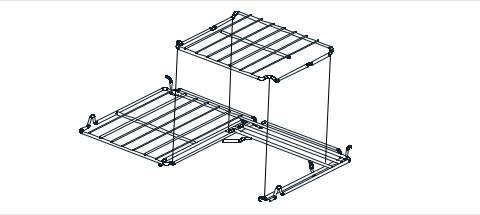
Getting Started
side. A second shorter item can then be placed on the half rack (above the first shorter item). This allows for easier access to all items and better utilization of the oven cavity.
Tip: The removable section can also be used outside of the oven as a trivet or cooling rack.
|
Figure 7: Half Oven Rack |
Oven Bottom |
Do not place food directly on oven bottom. Do not use aluminum foil or protective |
|
liners to line any part of an appliance, especially surface unit drip bowls or oven |
|
bottom. Installation of these liners may result in a risk of electric shock or fire. |
Oven Vent |
Free-standing Models: |
|
The oven vent is located below the display above the rear left cooktop element. It |
|
is normal to see steam escaping from the vent and condensation may collect on |
|
the backguard and cooktop. This area may become hot when the oven is in use. |
|
Do not block the vent as it is important for air circulation. |
|
Slide-in Models: |
|
The oven vent is located above the oven door handle. Warm air may be released |
|
from the vent before, during and after cooking. It is normal to see steam escaping |
|
from the vent and condensation may collect in this area. This area may be warm |
|
when the oven is in use. Do not block the vent as it is important for air circulation. |
Automatic Shutoff |
The oven will automatically shut off after 12 hours (24 hours if the time format is |
|
set for 24 hour in the Select Function section). |
Self-Cleaning |
The oven features a self-cleaning function that eliminates the manual labor |
|
involved with cleaning your oven. |
Indicators and Other Features |
Beep - Signals that more information must be entered or confirms the receipt of |
|
an entry. A Beep also signals the end of a program or an oven error. |
|
End-of-Cycle Indicator - To indicate when a mode is finished, 3 consecutive |
|
beeps will sound. |
|
Default Settings - The cooking modes automatically select the default tempera- |
|
ture. These can be changed when a different one is needed. |
|
Flashing Symbol or Number - Signals an incomplete setting and calls for |
|
another step or START to be pressed. |
|
F Number Codes -These codes display when there is a problem with the range. |
English 9
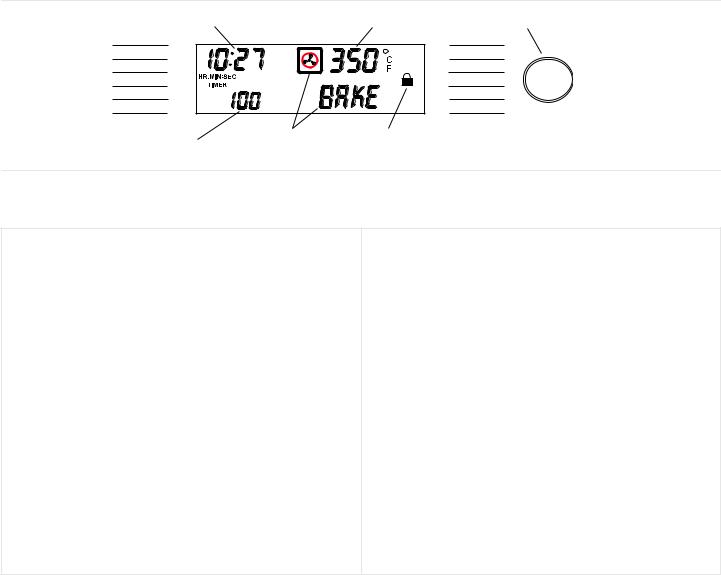
Getting Started
Cooling Fan (Slide-in models only) The cooling fan runs during all oven modes. It may run during heavy cooktop use as well. You may hear it running and you may feel warm air as it is released from the oven vent. This is normal.
Convection Fan |
The convection fan operates during any convection mode. When the oven is oper- |
||||
|
ating in the convection mode, the fan will turn off automatically when the door is |
||||
|
opened. The convection fan does run during self-clean, although not at the begin- |
||||
|
ning of the mode. |
|
|
||
|
Note: On some models, the convection fan also runs during preheat for the bake |
||||
|
mode. |
|
|
|
|
Control (Panel) |
|
|
|
|
|
Oven Control Panel |
|
|
|
|
|
Clock |
|
Oven Temperature |
Control Knob |
||
|
|
|
|||
Light |
AM |
|
|
Cooking Mode |
|
|
PM |
|
|
|
|
Time |
|
|
|
Temperature |
|
Off |
|
|
|
Start |
|
|
Cooking |
Lock Indicator |
|
||
Preheat Temperature Mode Indicator |
|
|
|
||
|
|
|
|
Figure 8: Oven Control Panel |
|
Table 2: Oven Control Panel |
|
|
|
|
|
Clock– Shows the time of day with a 12 or 24 hour option. |
Off - Press pad to turn off oven and/or warming drawer. |
||||
Also displays the timer and times associated with delayed |
Oven Temperature - Shows the oven temperature. |
||||
cooking and cleaning modes. Turn the control knob to tog- |
|||||
|
|
||||
gle between timer and clock display. Press Time and turn |
Preheat Temperature - Displays temperature of oven dur- |
||||
the control knob to change the time of day or the |
|
ing preheat mode. |
|||
timer. |
|
|
Probe Indicator (some models) - Indicates that the probe |
||
|
|
|
|||
Cooking Mode - Press pad to display cooking mode. |
|
is properly inserted into the probe receptacle in the oven. |
|||
Cooking Mode Icon – Shows the cooking elements that |
|
Start - Press pad to complete an entry. |
|||
are active for the mode that is selected. The icon will also |
Temperature - Press pad to select cooking temperature. |
||||
display a fan if the convection fan is utilized in the selected |
|||||
|
|
||||
mode. |
|
|
Time - Press pad to set or change the time of day or the |
||
Control Knob - Used to set the clock, timers, select cook- |
timer. |
|
|||
|
|
||||
ing mode and temperature. Turn clockwise to increase and |
Timer – There are two timers - TIMER 1 AND TIMER 2; |
||||
turn counterclockwise to decrease. |
|
|
Each counts down the time in hours and minutes. With |
||
Light - Press pad to turn oven light on or off. |
|
less than 60 minutes remaining, the timer also displays |
|||
|
seconds. Press Time to access the timers. |
||||
|
|
|
|||
Door Locking Indicator - Icon is displayed during the |
|
Warming Drawer Indicator - Indicates that the warming |
|||
self-clean mode when the door is locked. DO NOT attempt |
|||||
drawer (some models) is on. Also displays the warming |
|||||
to open the door until the lock symbol is no longer present. |
|||||
drawer setting. |
|||||
|
|
|
|||
|
You control the operation of the range by using the touch pads and dial on the |
||||
|
backguard and the knobs on the front panel. |
||||
|
The backguard touchpads, in conjunction with the dial on the backguard, are used |
||||
|
to select an oven mode, set the oven temperature, set the time(s) and to set up |
||||
|
your range. To use the touchpad, press the center part of the pad with the flat part |
||||
English 10
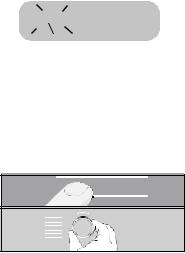
Getting Started
|
of your fingertip. A beep will sound to indicate that the selection has been made. |
|
Turn the dial on the backguard to the desired setting and press start. |
|
The knobs on the front panel of the range are used to control the heat level of the |
|
elements. Push down and turn to the desired temperature. |
|
See the sections on Using the Cooktop, Using the Oven and Using the Warming |
|
Drawer for detailed instructions. |
The Clock |
|
About the Clock |
• Always set the clock after installation or after a power failure. Once power |
|
returns to the oven, the clock defaults to 12:00 am. |
|
• The time of day is displayed in hours and minutes. |
|
• The clock time will appear during all oven operations except when the timer is |
|
running. |
|
• The oven is preset to a 12 hour clock and indicates AM and PM. To switch to |
|
a 24 hour clock, see "Select Function” section. |
|
• If you do not complete the operation of setting the clock, the oven will beep |
|
periodically as a reminder to set the clock time. Press OFF to stop the beep- |
|
ing. |
Setting the Clock |
1. CLOCK will be displayed and the hour digits |
|
|
|
|
|
|
||
|
will flash. Turn knob to select hour and AM or |
12: 00 AM |
CLOCK |
|
|
PM. |
|
|
|
|
|
|
|
|
2.Press Time. CLOCK will still be displayed and the minute digits will flash.
3.Turn knob. Set minutes.
4.Press Time and the clock is now set.
Note: If operation is not completed, the oven will beep periodically as a reminder to set clock time. Press OFF.
Changing the Clock |
1. |
Press Time. TIMER 1 flashes in display. |
|
2. |
Turn knob to select CLOCK. |
|
3. |
Press Time and hour digits flash. |
|
4. |
Turn knob to change hours. |
|
5. |
Press Time again and minute digits flash. |
|
6. |
Turn knob to change minutes. |
|
7. |
Press Time again and the clock is set. |
1Time
2Cooking ModeStartTemperature
The Select Functions
Menu
Note: To cancel the TIME selection when setting the clock, press OFF at any time while in the clock mode.
SELECT FUNCTIONS is the section of the menu where you can set or change the range features listed below.
To access the SELECT FUNCTION menu
1.Press and hold COOKING MODE press pad for five (5) seconds. SELECT FUNCTION is displayed.
2.Turn knob slowly to desired feature. There will be a slight delay before each message (or feature) can be seen in the display. Turn knob slowly and wait approximately one second for display to show next feature.
3.Press START to choose the function.
4.Turn knob to desired setting and press START.
When all settings for the function are complete, SELECT FUNCTION flashes again.
5.Press OFF to exit the Select Functions Menu.
English 11

Getting Started |
|
|
Change the Beep Vol- |
The volume of the control beep can be changed from LOW (softest) to HIGH |
|
ume |
(loudest). The control default for beep volume is Medium. |
|
|
1. |
Access SELECT FUNCTIONS Menu. |
|
2. |
Turn knob clockwise until VOLUME is displayed. |
|
3. |
Press Start. |
|
4. |
Turn knob to select volume level Low, Medium or High. |
|
5. |
Press Start. |
Change the Tempera- |
The oven has been preset to the Fahrenheit temperature scale. The feature |
|
ture Scale |
allows you to switch between Fahrenheit and Celsius temperature. |
|
|
1. |
Access SELECT FUNCTIONS Menu. |
|
2. |
Turn knob clockwise until SELECT TEMP F-C is displayed. |
|
3. |
Press Start. |
|
4. |
Turn knob to select Fahrenheit (F) or Celsius (C). |
|
5. |
Press Start to accept new selection. |
Turn Clock Display ON Clock time display can be turned off. The default display is on. or OFF
1.Access SELECT FUNCTIONS Menu.
2.Turn knob clockwise until CLOCK DISPLAY is displayed.
3.Press START.
4.Turn knob to select ON or OFF
5.Press START to accept new selection.
Access Demo Mode The demo mode is for appliance store use only.
Change the Display |
Language choices are English, Spanish, and French. English is the default lan- |
|
Language |
guage. Note: The SELECT FUNCTIONS menu is displayed in English only, |
|
|
regardless of which language is selected. |
|
|
1. |
Access SELECT FUNCTIONS Menu. |
|
2. |
Turn knob clockwise until desired language is displayed. |
|
3. |
Press Start. |
|
4. |
Turn knob clockwise to select a different language. |
|
5. |
Press Start to accept a language change. |
Lock / Unlock the Oven |
The oven keypad can be locked for safety purposes. This feature can be used to |
|
Control Panel |
prevent changes to the oven function. This function DOES NOT lock the oven |
|
|
door. |
|
|
1. |
Access SELECT FUNCTIONS Menu. |
|
2. |
Turn knob clockwise until LOCK KEYS is flashing. |
|
3. |
Press Start. KEY PAD LOCKED is displayed. The display will beep if a key is |
|
|
pressed to indicate that the keypad is locked. |
|
4. |
To unlock keypads, press Cooking Mode and hold for 5 seconds. Display will |
|
|
read UNLOCKING KEY PAD. |
|
5. |
When unlocked, the clock will again appear in the display. |
Change the Oven |
This feature allows the adjustment of the oven temperature if food is consistently |
|
Temperature Offset |
too brown or too light. |
|
|
1. |
Access SELECT FUNCTIONS Menu. |
|
2. |
Turn knob clockwise until OVEN TEMP OFFSET is displayed. |
|
3. |
Press START. 0° F is displayed. |
English 12

|
|
Getting Started |
|
4. |
Turn the knob to the right to increase temperature to +25° F and to the left to |
|
|
decrease to -25° F. The temperature changes by 5° F increments. |
|
5. |
Press START to accept a temperature change. |
Reset the Factory Set- |
This feature is used to change all the “Select Functions” settings back to the origi- |
|
tings |
nal factory settings (or defaults). |
|
|
1. |
Access SELECT FUNCTIONS Menu. |
|
2. |
Turn knob clockwise until RESET DEFAULTS is displayed. |
|
3. |
Press START. Display reads SELECT FUNCTIONS. |
Set the Sabbath Feature |
About the Sabbath Feature |
|
|
The Sabbath Feature is for religious faiths with “no work” requirements on the |
|
|
Sabbath. |
|
|
• |
The oven will bake for 73 hours before automatically turning off. |
|
• |
While baking in Sabbath mode, the display will show SABBATH and the |
|
|
BAKE icon will be displayed. The clock will be off and no temperature will |
|
|
show in the display. |
|
• |
During the Sabbath mode, only the OFF key will operate. Press OFF at any |
|
|
time during the Sabbath mode to end the mode and turn off the oven. |
|
• |
At the end of 73 hours, the oven will turn off automatically and the display will |
|
|
show SABBATH END. Press Off to return to time of day. |
|
• |
The warming drawer does not operate with the Sabbath feature unless the |
|
|
feature is also activated in the oven. |
|
• |
The probe CANNOT be used during the Sabbath mode. |
Setting the Sabbath Feature for the Oven Only
1. Verify that the oven is turned off.
1.Access SELECT FUNCTIONS Menu.
2.Turn knob clockwise until SABBATH OPTION appears.
3.Press START. BAKE will show in display and temperature will flash.
4.Turn knob to set oven temperature.
5.Turn oven light on if desired (press LIGHT).
Note: The light cannot be changed after this point. It will stay on or off, as selected, during the entire Sabbath mode.
6. Press START. Oven starts after 5 seconds.
The oven operates for 73 hours and then turns off automatically.
Setting the Sabbath Feature for both the Warming Drawer and the Oven.
Note: warming drawer does not operate with the Sabbath feature unless the feature is also activated in the oven.
1.Turn the warming drawer on to the desired heat setting. See “Turning on the Warming Drawer” on page 21.
2.Verify that the oven is turned off.
3.Access SELECT FUNCTIONS Menu.
4.Turn knob clockwise until SABBATH OPTION appears.
5.Press START. BAKE will show in display and temperature will flash.
6.Turn knob to set oven temperature.
7.Turn oven light on if desired (press LIGHT).
Note: The light cannot be changed after this point. It will stay on or off, as selected, during the entire Sabbath mode.
English 13

Change the Time Format
8.Press START. Oven starts after 5 seconds. Sabbath Feature is activated for both the warming drawer and the oven.
The oven and warming drawer operates for 73 hours and then turn off automatically.
Setting the Sabbath Feature for the Warming Drawer Only
The warming drawer does not operate with the Sabbath feature unless the feature is also activated in the oven. See “Setting the Sabbath Feature for both the Warming Drawer and the Oven.” on page 13.
The clock can be set to a 12 hour or 24 hour format. The default for clock format is 12 hour.
1.Access SELECT FUNCTIONS Menu.
2.Turn knob clockwise until TIME FORMAT is displayed.
3.Press Start.
4.Turn knob to select 12 hour or 24 hour format.
5.Press Start to accept new selection.
0.0Turn Automatic Convec- This feature automatically converts package or recipe temperatures for use with
tion Conversion ON or OFF
the convection bake mode. The default setting is “on”.
1.Access SELECT FUNCTIONS Menu.
2.Turn knob clockwise until AUTO CONVECT BAKE is displayed.
3.Press Start.
4.Turn knob to select ON or OFF.
5.Press Start to accept new selection.
Before Using the Appliance for the First Time
•Remove all packing materials and labels from range. Remove packing materials from inside the oven and inside the drawer.
•While cool, wipe with a clean, damp sponge and dry.
•Apply the glass ceramic cooktop cleaner to the glass ceramic cooktop. Buff with a clean cloth. See Care and Cleaning Section.
•There may be a slight odor during first uses; this is normal and will disappear.
•Optimum cooking results depend on proper cookware being used.
•The cooking surface will hold the heat and remain hot up to 30 minutes after the elements have been turned off.
•Read and understand all safety precautions and Use and Care Manual information prior to operating.
Operation - Cooktop
This section explains how to operate the cooktop. See “Getting the Most Out of
Your Cooktop” on page 22 for guidelines to improve cooktop results.
About the Cooktop
Use the cooktop for surface cooking applications such as boiling, frying, simmering, steaming and sauteing.
English 14
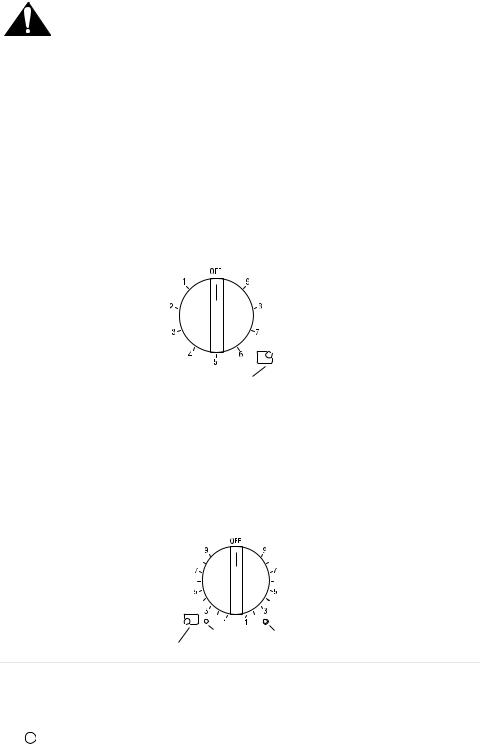
Operation - Cooktop
Operation
CAUTION
•Foods packaged in aluminum foil should not be placed directly on the glass ceramic surface for cooking. Aluminum foil can melt and cause permanent damage.
•Plastic, paper and cloth can melt or burn when in contact with a hot surface. Do not let these items come in contact with the hot glass ceramic surface.
•Do not allow pans to boil dry. This can permanently damage the pan, the element and the cooktop glass.
Setting the Burner Heat
Level
Single Element Control Knob |
To turn on a single element, push in on the control knob and turn in either direc- |
||
|
tion to the desired heat setting. |
||
|
|
|
|
|
|
|
|
|
Element Location |
||
|
|
|
|
|
|
|
Figure 9: Single Element Burner Knob |
Dual Element Control Knob |
To turn ON the small, inner element, push in on the control knob and turn it coun- |
||
|
terclockwise. Set to desired heat level. |
||
|
To turn ON both the inner and outer elements together, push in on the control |
||
|
knob and turn it clockwise to the desired setting. |
||
|
|
|
|
|
|
|
|
Inner Element Outer Element
Element Location
Figure 10: Dual Element Burner Knob
Triple Element Control Knob (some To turn on the small inner element only, push in on the control knob and turn it to
models) |
symbol (counterclockwise). Turn knob left or right to set the heat level. |
the |
To turn on the inner and middle elements, push in and turn the control knob to the  symbol. Turn knob left or right to set the heat level.
symbol. Turn knob left or right to set the heat level.
English 15
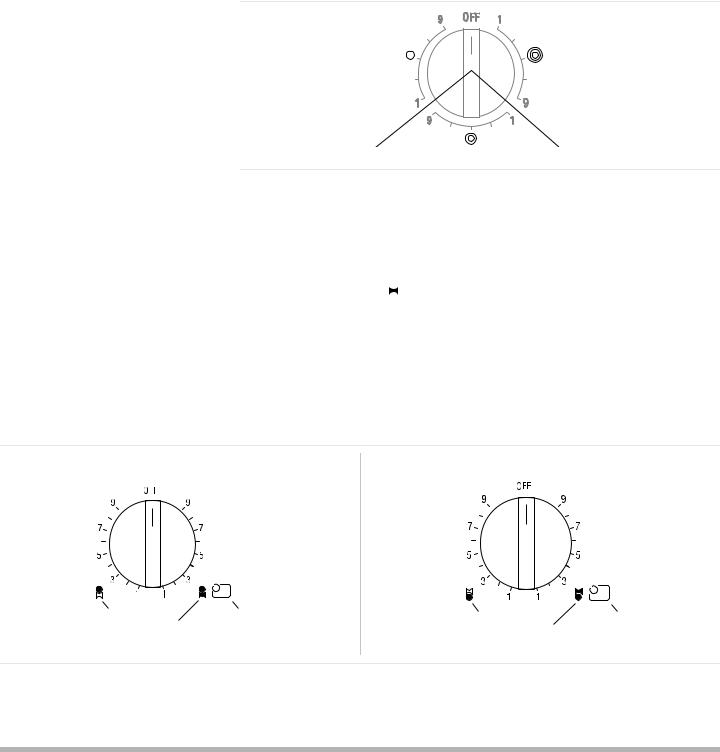
To turn on all three elements, Push in and turn the control knob to the  icon. Turn knob left or right to set the heat level.
icon. Turn knob left or right to set the heat level.
Inner |
All Three |
Element |
Elements |
Only |
|
Inner and Middle Element
Bridge Element Control Knob (some models)
Figure 11: Triple Element Knob
The bridge element connects two single elements to create one long cooking surface.
Depending on the model, the bridge element is either activated in conjunction with
the front single element ( ) or the rear single element (
) or the rear single element (  ). Refer to the control knob on your appliance to determine your configuration.
). Refer to the control knob on your appliance to determine your configuration.
Turn ON the bridge element and the small element together
1.Push in on the control knob and turn clockwise to the desired heat setting. Tip: To complete the connection and create an even longer cooking surface , turn ON the other single element, too.
To use the single element without bridge
1. Turn the knob counterclockwise.
Bridge element activated with |
Bridge element activated with |
||||
front single element: |
rear single element: |
||||
|
|
|
|||
|
|
|
|
|
|
|
|
|
|
|
|
|
|
|
|
|
|
|
|
|
|
|
|
Rear Single Element |
Element Location |
Front Single Element |
Element Location |
|
|||
Bridge Element with |
|
Bridge Element with |
|
Rear Single Element |
|
|
|
|
Front Single Element |
|
|
|
|
|
Figure 12: Bridge Element Knob
Operation - Oven
This section explains how to operate the oven. See “Getting the Most Out of Your
Oven” on page 24 for guidelines to improve oven results.
About the Oven
English 16

Operation
Setting the Cooking
Mode
and Temperature
Automatic Convection Conversion (models with convection bake)
Hot Oven Indicator
Operation - Oven
CAUTION
Do not use aluminum foil or protective liners to line any part of an appliance, especially surface unit drip bowls or oven bottom. Installation of these liners may result in a risk of electric shock or fire.
Note: To back out of a current mode, press OFF. (Selecting OFF when not setting the cooking mode will turn the oven off.)
1.Press COOKING MODE.
2.BAKE will flash in the display.
3. If no change is made within 5 seconds, |
6: 35 PM |
380 |
control will beep and flash. If this occurs, press START.
4.To change the cooking mode, turn knob.
5.Press START.
6.The selected mode will appear in the display, along with the default temperature for that mode, which will be blinking.
7.To select a different temperature, turn knob to the right or left (in 5° increments) to desired temperature.
8.Press START. If not pressed, oven automatically turns on in 5 seconds.
9.The display alternates between the cooking mode and preheat.
The preheated temperature is displayed, starting at 100ºF. The actual temperature increases until set temperature is reached, at which point the oven will beep.
10.To change temperature during cooking, press Temperature. Turn the knob to select new temperature and press START.
11.Once cooking has been completed, press OFF to turn off oven.
In the convection bake mode, the temperature is automatically reduced 25° F from the package or recipe temperature. Simply enter the package or recipe temperature when setting the mode and the range calculates the correct temperature.
The Automatic Convection Conversion feature can be turned off to allow for manual temperature adjustment. See “Turn Automatic Convection Conversion ON or OFF” on page 14 for details.
When the Automatic Convection Conversion feature is activated, the display will read AUTO CONV BAKE. When the feature is turned off, it will read CONV BAKE.
After the oven has been turned off, HOT appears in the display where the cooking mode was to indicate that the oven is off but still hot. When the oven temperature drops below 176° F, HOT is no longer seen in the display.
Using the Timer
Notes:
•If you do not finish setting the timer, the oven will beep periodically as a reminder to set the time. Press OFF to exit the TIMER mode. (Selecting OFF when not setting the timer will turn the oven off.)
•Turn the knob to display the time of day or further information about the oven mode when the timers are in use.
To set the timer:
English 17

Operation - Oven |
|
|
|
|
|
|
|
|
|
|
|
1. |
Press TIME and TIMER 1 will flash in display. |
|
|
|
|
|
|
|
|
|
|
|
0: 00 |
|
|
|
||||
|
|
|
|
|
|
|
TIMER |
1 |
||
|
|
Turn clockwise and TIMER 2 will be displayed. |
|
|
|
|
|
|
|
|
|
|
Select TIMER 1 or 2, then press TIME. SET |
1 : |
|
00 |
|
|
|
||
|
|
|
|
|||||||
|
|
TIMER 1 (2) appears in display. Minutes flash. |
|
|
|
|
|
|
|
|
|
|
|
|
|
|
|
|
|
|
|
|
|
HR:MIN Set TIMER |
2 |
|||||||
|
|
|
||||||||
|
2. |
Turn knob to set minutes. If setting only minutes, |
2: |
|
02Pm |
|
||||
|
|
|
||||||||
|
|
press START. Otherwise, continue to step 4. |
|
|
||||||
|
3. |
Press TIME again and the hours will flash. |
|
|
|
|
|
|||
|
HR:MIN Set TIMER |
2 |
||||||||
|
4. |
Turn knob to set hours. |
|
|
|
|
|
|
|
|
|
5. |
Press TIME again. The TIMER is now set. |
|
|
|
|
|
|
|
|
|
6. |
If TIME or START is not pressed, oven will begin beeping and timer display |
||||||||
|
|
will begin flashing. |
|
|
|
|
|
|
|
|
Changing the Timer/s |
1. |
Press TIME. TIMER 1 will appear in display. |
0: 00 AM |
|
||||||
|
|
Select either TIMER 1 or 2. |
|
|||||||
|
2. |
Press TIME. RESET TIMER 1 (2) appears in |
|
|
|
|
|
|
|
|
|
|
|
|
|
TIMER 1 |
|||||
|
|
the display. Minute digits flash. |
|
|
|
|
|
|
|
|
|
|
|
|
|
|
|
|
|
|
|
|
3. |
Turn knob clockwise or counterclockwise to change minutes. |
|
|||||||
|
4. |
Press TIME again and hour digits will flash. |
|
|
|
|
|
|
|
|
|
5. |
Turn knob clockwise or counterclockwise to change hours. |
|
|||||||
|
6. |
Press TIME and new time is set. |
|
|
|
|
|
|
|
|
Clearing the Timer/s |
1. |
Press TIME once. TIMER 1 flashes. |
|
|
|
|
|
|
|
|
|
2. |
Turn knob to select CLEAR TIMER 1(2). |
|
|
|
|
|
|
|
|
|
|
Press TIME. |
0: 00 |
|
|
|
||||
|
|
|
|
|
||||||
|
3. |
If Time pad is not pressed, range will beep and |
|
|
|
|
CLEAR TIMER 1 |
|||
|
|
display will continue flashing. |
|
|
|
|
|
|
|
|
|
|
|
|
|
|
|
|
|
|
|
|
4. |
Press TIME to return to the main screen. |
|
|
|
|
|
|
|
|
Cancelling |
If operation is not completed, the oven will beep periodically as a reminder to set |
|||||||||
|
time. Press OFF to exit the Timer mode. Selecting OFF when not in a setting |
|||||||||
|
mode will turn off the oven. |
|
|
|
|
|
|
|
|
|
Using Timed or Delayed Cook
Setting a Timed Mode
The TIMED COOK feature sets the oven to a cooking mode for a set period of time and then turns it off. The TIMED COOK feature is available for each of the following oven modes: Bake, Convection Bake and Convection Roast.
•Be sure that the time-of-day clock displays the correct time before beginning. See “Changing the Clock” on page 11 to adjust the time.
•At end of the programmed cooking time, the oven will automatically turn off.
•Delayed cooking is not recommended for foods that need to rise (i.e.; cookies, cakes, breads, souffles, etc.)
1.Press COOKING MODE.
2.BAKE will be displayed. To select a different cooking mode, turn the knob.
3.Press START.
4.Turn knob to select desired temperature.
Note: Time required for the oven to reach temperature must be included in the set cooking time.
5.Press TIME. TIMED BAKE appears.
1:20 350° F
6. Press TIME. SET BAKE TIME appears in the |
|
|
display and minutes flash. |
HR:MIN |
TIMED BAKE |
7.Set minutes. Press TIME.
8.Hours Flash. Set hours. Press START.
9.TIMED BAKE appears in display and the oven begins to preheat.
After cooking is complete, display flashes TIME COOK END and reminder beeps will sound. Press OFF to clear.
English 18

Delaying the Start of a Timed Mode
To Check the Cooking Time and
Stop Time After a Delay Has Been
Set
Setting the Sabbath Feature
Using the Probe (some models)
Setting the Probe
Operation - Oven
1.Follow steps 1 through 5 above.
2.Turn knob until DELAYED BAKE appears.
3. |
Press Time. SET BAKE TIME appears in dis- |
5: 00 |
|
400 oF |
||
|
|
PM |
||||
|
|
|||||
|
play and minutes flash. |
HR:MIN |
DELAYED BAKE |
|||
4. |
Set minutes and then press TIME. Hours Flash. |
|||||
|
|
|
|
|||
5. |
Set hours and then press TIME. SET BAKE END appears in the display. |
|||||
6. |
Press TIME. |
|
|
|
|
|
7. |
Use knob to enter the time of day the oven will stop cooking or turn off. |
|||||
8. |
Set hours and then press TIME. |
|
|
|
|
|
9. |
Set minutes and then press TIME. |
|
|
|
|
|
Note: The clock automatically calculates time of day at which cooking mode starts and stops. The displayed cooking time counts down by the minute.
10. At the end of the programmed cooking time, the oven will automatically turn off. Display will show TIME COOK END and reminder beeps will sound. Press OFF to clear.
Note: Remove food from oven immediately after cycle has finished to prevent overcooking. Food left in the oven will cook even after the cycle is complete.
1.Press Time.
2.Turn knob to BAKE END or BAKE TIME.
3.Press Time.
See “Set the Sabbath Feature” on page 13.
This section explains how to operate the probe. See “The Probe (some models)” on page 25 for guidelines, tips and suggestions.
The probe can be used to determine the internal doneness or the “END” temperature of many foods,especially meats and poultry.
The temperature range for the probe is 135°F to 200°F (57°C to 93°C). Oven temperature can be set for 100°F up to 450°F (38°C up to 232°C).
1.Prepare meat and place in roasting pan (or on rack in roasting pan as recipe specifies). Insert the probe into the meat. Make sure the probe is not touching gristle, fat, bone, the roast rack or the pan. See “Inserting the Probe” on page 25 for detailed instructions.
Note: Do not connect to probe receptacle until probe tip is properly inserted into meat.
2.Place roasting pan with meat in cold oven on recommended oven rack. Plug probe into the probe receptacle. The probe symbol will appear in display.
Note: The probe temperature can only be set when the probe is installed in the oven.
3.Press COOKING MODE and select BAKE, CONVECTION BAKE or CONVECTION ROAST.
4.Press START. The default oven temperature will appear.
5.Turn knob to change oven temperature if necessary.
6.Touch START.
7.Turn knob to set the probe temperature (desired end temperature of the food).
8.Press START.
The chosen oven temperature is displayed in the upper right hand corner of the display.
English 19
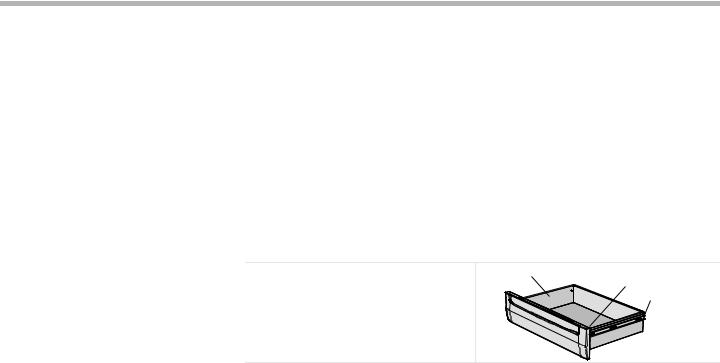
Changing the Oven Temperature
When Using the Probe
Changing the Probe Temperature
The probe temperature is displayed in the center to the left of the cooking mode. It starts at 80 degrees and increases in 5°F increments until the chosen probe temperature is reached.
The oven is preheated when the beep signals once.
When the set probe temperature is reached, END appears in display and oven turns off.
1.Touch TEMPERATURE. Oven temp will flash in the display.
2.Turn the knob to desired temperature and press START twice.
1.Touch TEMPERATURE. The oven temperature will flash.
2.Press start and PROBE TEMP will flash.
3.Turn the knob to desired temperature and press START again.
Note: Always remove probe from oven when cooking is complete. The probe symbol will remain in the display until the probe is removed. Do not leave probe attachment in oven during self-clean. Oven will not self-clean with the probe installed in the oven
Operation - Warming Drawer (some models)
This section explains how to operate the warming drawer. See “Getting the Most Out of Your Warming Drawer” on page 30 for guidelines to improve warming drawer results.
About the Warming Drawer
Warming Drawer Specifications
The warming drawer will keep hot, cooked foods at serving temperature. Warming drawer settings are Low, Medium, and High.
1
Parts Key: |
2 |
3
1. Stainless Steel Drawer Interior
2. Gasket
3. Rail Lock
Figure 13: Warming Drawer Parts
Drawer Interior: 25" W x 17" D x 5" H
Dish sizes:
•2 -9 x 13" Pyrex 3-quart dishes, side by side.
•2 -9 1/2 x 15" Pyrex 4-quart dishes, side by side.
•4 -10 1/2" plates, single or stacked
•3 -11" plates, single or stacked
English 20

Operation - Warming Drawer (some models)
Warming Drawer Settings: The warming drawer has three
settings: Low, Medium and High. The icons below are seen Low in the display when the corresponding setting is selected:
Medium
High
Figure 14: Warming Drawer Settings
Operation
CAUTION
To maintain food safety, follow these guidelines:
• DO NOT use the warming drawer to heat cold food (exception: it is safe to use the drawer to crisp crackers, chips or dry cereal and to warm plates).
• Be sure to maintain proper food temperature. The USDA recommends holding hot food at 140°F or warmer.
• DO NOT warm food for longer than one hour.
• Plastic containers, plastic wrap or aluminum foil can melt if in direct contact with the drawer or a hot cooking container. If it melts onto the drawer, it may not be removable.
Preheating |
For best results, preheat the warming drawer when warming food. |
|
Preheat Times: |
• |
Low: 10 minutes |
|
• |
Medium: 15 minutes |
|
• |
High: 20 minutes |
Turning on the Warming |
|
|
Drawer |
|
|
When Only Using the Warming |
1. |
Press COOKING MODE. |
Drawer |
2. |
Turn knob to select WARMING DRAWER. |
|
3. |
Press START. |
|
4. |
Turn knob to select heat setting. |
|
5. |
Press START. |
When Also Using The Oven |
1. |
Press COOKING MODE. |
|
2. |
Press START to select WARMING DRAWER. |
|
3. |
Turn knob to select heat setting. |
|
4. |
Press START. |
Setting the Sabbath Feature |
Note: The warming drawer does not operate with the Sabbath feature unless the |
|
|
feature is also activated in the oven. See “Setting the Sabbath Feature for both |
|
|
the Warming Drawer and the Oven.” on page 13. |
|
|
1. |
Turn the warming drawer on the desired heat level. |
|
2. |
Activate the Sabbath Feature. See “Set the Sabbath Feature” on page 13. |
English 21

Turning Off the Warming
Drawer
When Only Using the Warming |
1. |
Press OFF. |
Drawer |
|
|
When Using the Warming Drawer |
1. |
Press OFF. |
and the Oven |
2. |
Turn knob to select CANCEL DRWR, CANCEL OVEN, or CANCEL BOTH. |
|
3. |
Press OFF. |
Crisping Stale Items |
• |
Place food in low sided dishes or pans. |
|
• |
Preheat on Low. |
|
• |
Check crispness after 45 minutes. Add time as needed. |
Warming Empty Serving
Bowls and Plates
•Use only heat-safe dishes.
•Warm on setting appropriate for cooking container.
•Check dish temperature during warming period.
•Place empty plates or dishes in a cold warming drawer. Do not preheat drawer prior to placing dishes.
Getting the Most Out of Your Appliance
Getting the Most Out of Your Cooktop
Cooktop Cooking Guide
Boiling Water |
Time to boil can vary greatly depending on environmental conditions. Try the fol- |
|
|
lowing tips to decrease boil time: |
|
|
• |
Use a lid. |
|
• Use a pan that is appropriately sized for the amount of water and the size of |
|
|
|
the element. |
|
• Select a pan with a flat base (See “Cookware Selection Guide” on page 23 for |
|
|
|
details). |
|
• Choose a medium-weight pan (rather than a heavy-weight one). |
|
|
• Make sure that the pan is positioned so that the entire base is in contact with |
|
|
|
the element. |
|
• Start with water that is already warm. |
|
|
• Boil the smallest amount of water necessary. Smaller volumes will boil faster |
|
|
|
than larger volumes. |
Recommended Settings |
Use this chart as a guide for heat settings. A range of heat settings are listed |
|
|
because the actual setting depends on: |
|
|
• type and quality of pan (See “Selecting Cookware”), |
|
|
• type, quantity and temperature of the food, |
|
|
• |
element used and |
|
• |
the cook’s preference. |
The Heat Settings recommended are based on a 240 volt power source. If your cooktop is connected to 208 volts, the same heat settings apply but foods may
English 22
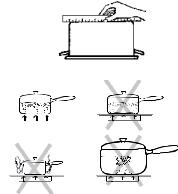
Getting the Most Out of Your Appliance
take a little longer to finish cooking.
Table 3: Cooking Guide
Uses |
|
Heat Settings |
|
|
|
Bringing water to boil |
9 - High |
|
|
|
|
Pan frying, sautéing, browning meat, deep fat frying |
6-8 - Med-High |
|
|
|
|
Most frying, eggs, pancakes, slow boil |
4-5 |
- Med |
|
|
|
Simmering, finish cooking, covered foods, steaming |
2-3 |
- Med Low |
|
|
|
Melting butter and chocolate |
1 - Low |
|
|
|
|
Bridge Element Tips (some models) • Use the bridge elements with only one single element for medium sized griddles and oval pots.
• For even heat distribution when using all three elements, start with the back element at a slightly higher setting than the front and bridge elements. Observe cooking performance and adjust accordingly.
• When using a pan that spans all three elements, set the back element at a different heat level than the front and bridge elements to keep prepared food warm or to prepare two different foods at one time.
Cookware Selection
Guide
Cookware Characteristics |
Pan selection directly affects cooking speed and uniformity. For best results select |
|||||||||||||||||||||||
|
pans with flat bases. When a pan is hot, the base (pan bottom) should rest evenly |
|||||||||||||||||||||||
|
on the surface without wobbling (rocking). Flat, medium-to-heavy-weight pans are |
|||||||||||||||||||||||
|
best. |
|||||||||||||||||||||||
To Test the Flatness of Your Pans |
Turn the pan upside down on the countertop and place a |
|||||||||||||||||||||||
|
ruler flat against the bottom of the pan. The bottom of the |
|||||||||||||||||||||||
|
pan and the straight edge of the ruler should be flush |
|||||||||||||||||||||||
|
against each other. |
|||||||||||||||||||||||
|
Another simple test to determine even heat distri- |
|||||||||||||||||||||||
|
bution across the cookware bottom is to place 1” |
|
|
|
|
|
|
|
|
|
|
|
|
|
|
|
|
|
|
|
|
|||
|
|
|
||||||||||||||||||||||
|
(25.4 mm) of water in the pan. Bring the water to a |
|
|
|
|
|
|
|
|
|
|
|
|
|
|
|
|
|
|
|
|
|
|
|
|
|
|
|
|
|
|
|
|
|
|
|
|
|
|
|
|
|
|
|
|
|
|
||
|
|
|
|
|
|
|
|
|
|
|
|
|
|
|
|
|
|
|
|
|
|
|
||
|
boil and observe the location of the bubbles as the |
|||||||||||||||||||||||
|
water starts to boil. Good, flat cookware will have |
|
|
|
|
|
|
|||||||||||||||||
|
|
|||||||||||||||||||||||
|
an even distribution of bubbles over the bottom |
|
|
|
|
|
|
|
|
|
|
|
|
|
|
|
|
|
||||||
|
|
|||||||||||||||||||||||
|
surface area. |
|
|
|
|
|
|
|
|
|
|
|
|
|
|
|
|
|
|
|
|
|
||
|
|
|
|
|
|
|
|
|
|
|
|
|
|
|
|
|
|
|
|
|
|
|
|
|
|
Matching Diameters – The base of the pan should cover or match the diameter |
|||||||||||||||||||||||
|
of the element being used. Pans may overhang the element area by 1" (25.4 mm) |
|||||||||||||||||||||||
|
all around. |
|||||||||||||||||||||||
|
Tight Fitting Lids – A lid shortens cooking/boiling time by holding heat inside the |
|||||||||||||||||||||||
|
pot. |
|||||||||||||||||||||||
Cookware Tips |
• Use of pots and pans with rounded (either concave or convex) warped or |
|||||||||||||||||||||||
|
dented bottoms should be avoided. See drawings below. |
|||||||||||||||||||||||
|
• Make sure the bottom of the pot or pan being used is clean and dry. |
|||||||||||||||||||||||
|
• Use pots and pans with thick, smooth metal bottoms. |
|||||||||||||||||||||||
|
• Do not slide metal pots across the cooktop. Pans may leave marks which |
|||||||||||||||||||||||
|
need to be removed immediately. See Care and Cleaning Section. |
|||||||||||||||||||||||
English 23
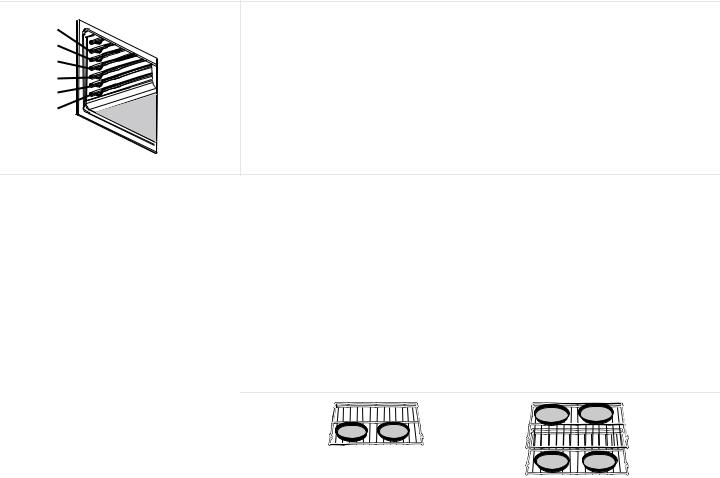
Getting the Most Out of Your Appliance
•Do not use glass pans as they may scratch the surface.
Specialty Pans |
Specialty pans such as griddles, roasters, pressure cookers, woks, water bath |
|
canners and pressure canners must have the same features as described above. |
|
Use only a flat-bottomed wok. Never place a support ring, such as a wok ring or |
|
trivet, on the cooking surface. |
Getting the Most Out of Your Oven
Oven Cooking Guide
Rack Position
|
• RACK POSITION 6 (highest position) – melting cheese, broiling thin foods |
6 |
• RACK POSITION 5 – broiling most meats, toasting bread |
5 |
• RACK POSITION 4 – broiling thicker meats |
4 |
• RACK POSITION 3 – most baked goods when baking on one rack, such as |
3 |
on cookie sheet or baking pan, cakes, frozen foods, biscuits, brownies, |
2 |
muffins |
1 |
• RACK POSITION 2 – Used for pies, casseroles, breads, bundt or pound |
|
cakes, small roasts or poultry. |
|
• RACK POSITION 1 (lowest position) – Use for angel food cake, large |
|
roasts, turkey. |
|
Figure 15: Rack Positions |
Multiple Rack Cooking |
When using multiple racks, follow the placement recommendations below. |
|
• Two rack: Use rack positions 2 and 5. |
|
• Three rack: (for convection bake): Use positions 1, 3 and 6. The rack in posi- |
|
tion 3 can be extension rack if desired. |
Pan Placement |
Baking results are better if pans are placed in the center of the oven. If baking |
|
more than one pan on a rack, allow at least 1" to 1 ½” of air space around the pan. |
When baking four cake layers at the same time, stagger pans on two racks so that one pan is not directly above the other. To allow for best baking results stagger pans as shown in the graphic below.
|
Pan placement on |
|
one rack |
|
Pan placement on |
|
two racks |
|
|
|
Figure 16: Pan Placement |
Baking Pans |
Here are some tips for cooking with baking pans: |
|
• Glass baking dishes absorb heat, therefore reduce oven temperature 25°F |
|
when baking in glass. |
|
• Shiny, smooth metal reflects heat resulting in lighter, more delicate browning. |
|
• Dark, rough or dull pans will absorb heat resulting in browner, crisper crust. |
|
Some manufacturers recommend reducing temperature 25° F when using |
|
these pans. Follow manufacturer recommendations. |
|
• Use glass or dark metal pans for pies. |
|
• Insulated baking pans may increase the recommended baking time. |
English 24

|
Getting the Most Out of Your Appliance |
Preheating the Oven |
Preheat the oven if the recipe recommends it. Preheating is necessary for good |
|
results when baking cakes, cookies, pastry and breads. Setting a higher tempera- |
|
ture does not shorten preheat time. Place oven racks in proper position before |
|
preheating. A beep will confirm that oven is preheated and selected oven temper- |
|
ature will be displayed. |
|
Note: Preheating the oven is not recommended when using the probe (some |
|
models). A hot oven will impair your ability to easily connect the probe to the |
|
receptacle and to insert it into the meat. |
The Probe (some models) |
• The oven is well insulated and the retained heat will continue to cook the meat |
|
after the oven has shut off. For this reason, remove the meat from the oven as |
|
soon as the control beeps. |
|
• Since meat continues to cook after being removed from the oven, set the |
|
internal (probe) temperature 5 - 10 degrees below the desired final internal |
|
temperature (exception: poultry). Allow standing time (10 -20 minutes) before |
|
carving the meat. |
|
• Always use the handle of the probe for inserting and removing. Use a |
|
potholder to remove since the probe becomes hot. |
|
• Remove the probe from the oven when it is not being used. |
|
• The probe cannot be used with frozen meats. For best results, completely |
|
thaw meats before using the probe. |
Inserting the Probe
•For meats, insert the probe tip into the thickest part and do not touch bone, fat, or gristle.
•For large poultry products and turkeys, insert the probe in the thickest part of the inner thigh.
•For other foods, such as a meatloaf, the probe tip should be located in the center of the thickest part of the food.
Oven Cooking Modes
Baking is cooking with dry, heated air. Both the Bake, Proof and Warm upper and lower element cycle to maintain the oven
temperature. Bake mode can be used to prepare foods like pastries and casseroles as well as to roast meats.
Note: Depending on the model, you may hear the convection fan while the oven is preheating for the bake mode. This is normal.
In the Proofing mode, the oven will use the upper and lower element to maintain a low temperature to proof bread.
•Proofing is the rising of a yeast dough.
•The Proofing mode temperatures are 85° to 110° F. The default temperature is 100° F.
•Loosely cover the bowl or pan and use any rack that accommodates the size of the container.
•Keep the door closed and use the oven light to check the rising of the dough.
In Warming mode, the upper and lower elements maintain a low temperature in the oven cavity in order to keep food at serving temperature.
•Use the Warming setting on the oven to keep foods hot until ready to serve.
•Warming mode temperatures are 140° - 220° F. Default temperature is 170°.
•Foods that must be kept moist should be covered with a lid or aluminum foil.
English 25
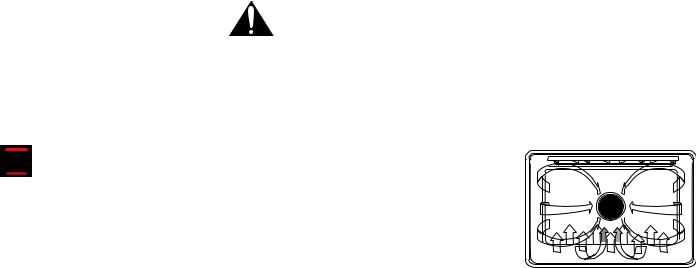
Getting the Most Out of Your Appliance
CAUTION
When using Warm mode, follow these guidelines:
•Do not use the Warm Mode to heat cold food.
•Be sure to maintain proper food temperature. The USDA recommends holding hot food at 140°F or warmer.
•DO NOT warm food for longer than one hour.
Convection baking is similar to baking. Heat Convection Bake comes from the lower heating element and a
third element behind the backwall. The main difference in convection baking is that the heat is circulated throughout the oven by the convection fan.
The Convection Bake mode is well-suited for baking large quantities of food on multiple racks.
It can be used to prepare cookies, pies, cupcakes, pastries, breads, snack foods and appetizers among other items.
The benefits of Convection Baking include:
•Slight decrease in cooking time
•Three rack cooking (more even browning)
•Higher Volume (yeast items rise higher)
•Ability to cook more items at once
For Best Results:
•Reduce recipe temperature by 25° F. Refer to Convection Baking chart.
•Place food in low-sided, uncovered pans such as cookie sheets without sides.
•Center baking pans side to side on the oven rack
Automatic Convection Conversion In the convection bake mode, the temperature is automatically reduced 25° F from the package or recipe temperature. Simply enter the package or recipe temperature when setting the mode and the range calculates the correct temperature.
The Automatic Convection Conversion feature can be turned off to allow for manual temperature adjustment. See “Turn Automatic Convection Conversion ON or OFF” on page 14 for details
When the Automatic Convection Conversion feature is activated, the display will read AUTO CONV BAKE. When the feature is turned off, it will read CONV BAKE.
Table 4: Convection Baking Chart
Food |
Item |
Rack |
Temp. (oF) |
Convection Bake Time |
|
Position |
(preheated oven)a |
(min.)b |
|||
|
|
||||
Cake |
Cupcakes |
3 |
350 |
17-19 |
|
|
Bundt Cake |
2 |
350 |
37-43 |
|
|
Angel Food |
1 |
350 |
35-39 |
|
|
|
|
|
|
|
Pie |
2 Crust, fresh, 9” |
2 |
375-425 |
45-55 |
|
|
2 Crust, frozen fruit, 9” |
2 |
375 |
68-78 |
|
|
|
|
|
|
|
Cookies |
Sugar |
3 |
350-475 |
6-11 |
|
|
Chocolate Chip |
3 |
350-375 |
8-13 |
|
|
Brownie |
3 |
350 |
29-36 |
|
|
|
|
|
|
English 26

|
|
|
|
Getting the Most Out of Your Appliance |
|
Table 4: Convection Baking Chart |
|
|
|
|
|
|
|
|
|
|
|
Food |
Item |
Rack |
Temp. (oF) |
Convection Bake Time |
|
Position |
(preheated oven)a |
(min.)b |
|
||
|
|
|
|||
Breads |
Yeast bread, loaf, 9x5 |
2 |
375 |
18-22 |
|
|
Yeast rolls |
3 |
375-400 |
12-15 |
|
|
Quick bread, loaf, 8x4 |
2 |
350-375 |
45-55 |
|
|
Biscuits |
3 |
375-400 |
11-15 |
|
|
Muffins |
3 |
425 |
15-19 |
|
|
|
|
|
|
|
Pizza |
Frozen |
3 |
400-450 |
23-26 |
|
|
Fresh |
3 |
425-450 |
12-15 |
|
|
|
|
|
|
|
a.This temperature must be manually reduced by 25° F if the Automatic Convection Conversion feature has been turned off.
b.This chart is a guide. Actual times depend on the mixes or recipes baked. Follow recipe or package directions.
Broil
Table 5: Broiling Chart
Broiling uses intense heat radiated from the upper element. The Broil mode is best suited to cooking thin, tender cuts of meat (1” or less), poultry and fish. It can also be used to brown breads and casseroles. Always broil with the door closed.
The benefits of Broiling include:
•Fast and efficient cooking
•Cooking without the addition of fats or liquids
•Browning as the food cooks
For Best Results:
•Preheat oven 3-4 minutes. Do not preheat for more than 5 minutes.
•Steaks and Chops should be at least 3/4” thick
•Brush fish and poultry with butter or oil to prevent sticking
•Use the broil pan and grid included with your range
•Do not cover the broiler grid with foil. It is designed to drain fats and oils away from the cooking surface to prevent smoking and spattering
•Turn meats once halfway through the recommended cooking time (see Broil Chart for examples).
•When top browning casseroles, use only metal or glass ceramic dishes such as Corningware®.
•Never use heat-proof glass (Pyrex®); they can’t tolerate the high temperature.
Food |
Item / Thickness |
Rack |
Broil |
Internal |
Time Side 1 |
Time Side 2 |
|
Position |
Setting |
Temp. (oF) |
(min.)a |
(min.)a |
|||
|
|
||||||
Beef |
Steak (3/4”-1”) |
|
|
|
|
|
|
|
Medium Rare |
5 |
high |
145 |
5-7 |
4-6 |
|
|
Medium |
5 |
high |
160 |
6-8 |
5-7 |
|
|
Well |
5 |
high |
170 |
7-9 |
6-8 |
|
|
Hamburgers (3/4”-1”) - Well |
4 |
high |
160 |
7-9 |
8-10 |
|
|
|
|
|
|
|
|
|
Poultry |
Breast (bone in) |
4 |
low |
170 |
21-23 |
18-20 |
|
|
|
|
|
|
|
|
|
Pork |
Pork chops (1”) |
4 |
high |
160 |
6-8 |
4-6 |
|
|
Sausage - fresh |
3 |
high |
160 |
5-7 |
4-6 |
|
|
Ham slice (1/2”) |
5 |
high |
160 |
2-4 |
2-3 |
|
|
|
|
|
|
|
|
|
Seafood |
Fish filets (3/4”-1”) buttered |
5 |
low |
Cook until |
9-11 |
Do Not Turn |
|
|
|
|
|
opaque and |
|
|
|
|
|
|
|
flakes easily |
|
|
|
|
|
|
|
|
|
|
English 27

Getting the Most Out of Your Appliance
Table 5: Broiling Chart
Food |
Item / Thickness |
Rack |
Broil |
Internal |
Time Side 1 |
Time Side 2 |
|
Position |
Setting |
Temp. (oF) |
(min.)a |
(min.)a |
|||
|
|
||||||
Lamb |
Chops (1”) |
|
|
|
|
|
|
|
Medium rare |
5 |
high |
145 |
4-6 |
2-4 |
|
|
Medium |
5 |
high |
160 |
5-7 |
4-6 |
|
|
Well |
5 |
high |
170 |
6-8 |
5-7 |
|
|
|
|
|
|
|
|
|
Bread |
Garlic bread slices (1”) |
5 |
high |
N/A |
2-4 |
Do Not Turn |
|
|
|
|
|
|
|
|
a.Broiling times are approximate and may vary slightly, Times are based on cooking with a preheated broil element.
Convection Broil (some models)
Table 6: Convection Broiling Chart
Convection Broil is similar to Broil. It combines intense heat from the upper element with heat circulated by a convection fan. The Convection Broil mode is well suited for cooking thick, tender cuts of meat, poultry and fish. Convection Broil is typically not recommended for browning breads, casseroles and other foods.
Always convection broil with the door closed. In
addition to the benefits of standard broiling, convection broiling is faster than standard Broiling.
Note: The only heat setting for the Convection Broil mode is High.
For Best Results:
•Preheat oven 3-4 minutes. Do not preheat more that 5 minutes.
•Meats should be at least 1 1/2” thick.
•Turn meats once halfway through the cooking time (See Convection Broil Chart for examples).
•Use the broil pan and grid included with your range.
•Do not cover the broiler grid with foil. It is designed to drain fats and oils away from the cooking surface to prevent smoking and spattering.
•Salt after cooking.
Food |
Item / Thickness |
Rack |
Broil |
Internal |
Time Side 1 |
Time Side 2 |
||
Position |
Setting |
Temp. (oF) |
(min.)a |
(min.)a |
||||
|
|
|||||||
Beef |
Steak (1 1/2” or more) |
|
|
|
|
|
|
|
|
Medium Rare |
3 |
high |
145 |
|
11-13 |
9-11 |
|
|
Medium |
3 |
high |
160 |
|
13-15 |
11-13 |
|
|
Well |
3 |
high |
170 |
|
15-17 |
13-15 |
|
|
Hamburger (more than 1”) - Well |
4 |
high |
160 |
|
11-13 |
8-10 |
|
|
|
|
|
|
|
|
|
|
Poultry |
Chicken quarters |
4 |
high |
180 |
- thigh |
14-16 |
12-14 |
|
|
|
|
|
170 |
- breast |
|
|
|
|
|
|
|
|
|
|
|
|
Pork |
Pork chops (1 1/4” or more) |
4 |
high |
160 |
|
7-9 |
6-8 |
|
|
Sausage - fresh |
4 |
high |
160 |
|
5-7 |
3-5 |
|
|
|
|
|
|
|
|
|
|
a.Convection broiling times are approximate and may vary slightly. Times are based on cooking with a preheated broil element.
English 28
